Effects of Beach Nourishment Project on Coastal Geomorphology and Mangrove Dynamics in Southern Louisiana, USA
Abstract
:1. Introduction
2. Methods and Materials
2.1. Study Area
2.2. Historical Oceangrophic Data
2.3. Remote Sensing
2.4. Image Classification
2.5. Analyses of Spatial Data
2.6. D Models
3. Results
3.1. Climatic and Oceanographic Data
3.2. Dynamics of the Beach Barrier before the Nourishment Project
3.3. Dynamics of the Beach Barrier after the Nourishment Project
3.4. Dynamics of the Backbarrier Wetlands
4. Discussion
4.1. The Effect of the 2013 Beach Nourishment Project on Coastal Morphodynamics
4.2. Dynamics of the Coastal Barrier and Relationship to the Wetlands
5. Conclusions
Supplementary Materials
Author Contributions
Funding
Institutional Review Board Statement
Informed Consent Statement
Data Availability Statement
Acknowledgments
Conflicts of Interest
References
- Coleman, J.M. Dynamic changes and processes in the Mississippi River delta. Bull. Geol. Soc. Am. 1988, 100, 999–1015. [Google Scholar] [CrossRef]
- Coleman, J.M.; Roberts, H.H.; Stone, G.W. Mississippi River Delta: An Overview. J. Coast. Res. 1998, 14, 698–716. [Google Scholar]
- Kolb, C.R.; Van Lopik, J.R. Geology of the Mississippi River Deltaic Plain Southeastern Louisiana; U.S. Army Engineer Waterways Experiment Station: Vicksburg, MS, USA, 1958. [Google Scholar]
- Lam, N.; Xu, Y.; Liu, K.; Dismukes, D.; Reams, M.; Pace, R.; Qiang, Y.; Narra, S.; Li, K.; Bianchette, T.; et al. Understanding the Mississippi River Delta as a Coupled Natural-Human System: Research Methods, Challenges, and Prospects. Water 2018, 10, 1054. [Google Scholar] [CrossRef] [Green Version]
- Couvillion, B.R.; Beck, H.J.; Schoolmaster, D.R.; Fischer, M. Land Area Change in Coastal Louisiana (1932 to 2016)-Persistent Land Change Spatial Data; U.S. Geological Survey Data Release: Reston, VA, USA, 2018.
- Reed, D.J.; Wilson, L. Coast 2050: A new approach to restoration of Louisiana coastal wetlands. Phys. Geogr. 2004, 25, 4–21. [Google Scholar] [CrossRef]
- Jafari, N.H.; Harris, B.D.; Stark, T.D. Geotechnical investigations at the caminada headlands beach and dune in coastal Louisiana. Coast Eng. 2018, 142, 82–94. [Google Scholar] [CrossRef]
- Nerem, R.S.; Beckley, B.D.; Fasullo, J.T.; Hamlington, B.D.; Masters, D.; Mitchum, G.T. Climate-change-driven accelerated sea-level rise detected in the altimeter era. Proc. Natl. Acad. Sci. USA 2018, 115, 2022–2025. [Google Scholar] [CrossRef] [Green Version]
- Blum, M.D.; Roberts, H.H. Drowning of the Mississippi Delta due to insufficient sediment supply and global sea-levelrise. Nat. Geosci. 2009, 2, 488–491. [Google Scholar] [CrossRef]
- Dietz, M.; Liu, K.; Bianchette, T.; Dietz, M.E.; Liu, K.; Bianchette, T.A. Hurricanes as a Major Driver of Coastal Erosion in the Mississippi River Delta: A Multi-Decadal Analysis of Shoreline Retreat Rates at Bay Champagne, Louisiana (USA). Water 2018, 10, 1480. [Google Scholar] [CrossRef] [Green Version]
- Jankowski, K.L.; Törnqvist, T.E.; Fernandes, A.M. Vulnerability of Louisiana’s coastal wetlands to present-day rates of relative sea-level rise. Nat. Commun. 2017, 8, 14792. [Google Scholar] [CrossRef] [Green Version]
- Johnson, C.L.; Chen, Q.; Ozdemir, C.E. Lidar time-series analysis of a rapidly transgressing low-lying mainland barrier (Caminada Headlands, Louisiana, USA). Geomorphology 2020, 352, 106979. [Google Scholar] [CrossRef]
- Kulp, M.; Penland, S.; Williams, S.J.; Jenkins, C.; Flocks, J.; Kindinger, J. Geologic Framework, Evolution, and Sediment Resources for Restoration of the Louisiana Coastal Zone. J. Coast. Res. 2005, 21, 56–71. [Google Scholar]
- Yao, Q.; Liu, K.; Ryu, J. Multi-proxy Characterization of Hurricanes Rita and Ike Storm Deposits in the Rockefeller Wildlife Refuge, Southwestern Louisiana. J. Coast. Res. 2018, 85, 841–845. [Google Scholar] [CrossRef]
- Yao, Q.; Liu, K.; Aragón-Moreno, A.A.; Rodrigues, E.; Xu, Y.J.; Lam, N.S. A 5200-year paleoecological and geochemical record of coastal environmental changes and shoreline fluctuations in southwestern Louisiana: Implications for coastal sustainability. Geomorphology 2020, 365, 107284. [Google Scholar] [CrossRef]
- Maiolo, M.; Mel, R.A.; Sinopoli, S. A Stepwise Approach to Beach Restoration at Calabaia Beach. Water 2020, 12, 2677. [Google Scholar] [CrossRef]
- Osland, M.J.; Day, R.H.; Hall, C.T.; Brumfield, M.D.; Dugas, J.L.; Jones, W.R. Mangrove expansion and contraction at a poleward range limit: Climate extremes and land-ocean temperature gradients. Ecology 2017, 98, 125–137. [Google Scholar] [CrossRef]
- Stevens, P.W.; Fox, S.L.; Montague, C.L. The interplay between mangroves and saltmarshes at the transition between temperate and subtropical climate in Florida. Wetl. Ecol. Manag. 2006, 14, 435–444. [Google Scholar] [CrossRef]
- Woodroffe, C.D. Response of tide-dominated mangrove shorelines in Northern Australia to anticipated sea-level rise. Earth Surf. Process. Landf. 1995, 20, 65–85. [Google Scholar] [CrossRef]
- Cohen, M.C.L.; Lara, R.J. Temporal changes of mangrove vegetation boundaries in Amazonia: Application of GIS and remote sensing techniques. Wetl. Ecol. Manag. 2003, 11, 223–231. [Google Scholar] [CrossRef]
- Mclvor, A.; Möller, I.; Spencer, T.; Spalding, M. Reduction of Wind and Swell Waves by Mangroves; Natural Coastal Protection Series: Report 1; Cambridge Coastal Research Unit Working Paper 40; The Nature Conservancy and Wetlands International: Wageningen, The Netherlands, 2012; Volume 1, 27p. [Google Scholar]
- Krauss, K.W.; McKee, K.L.; Lovelock, C.E.; Cahoon, D.R.; Saintilan, N.; Reef, R.; Chen, L. How mangrove forests adjust to rising sea level. New Phytol. 2014, 202, 19–34. [Google Scholar] [CrossRef] [PubMed] [Green Version]
- Cohen, M.C.L.; de Souza, A.V.; Rossetti, D.F.; Pessenda, L.C.R.; França, M.C. Decadal-scale dynamics of an Amazonian mangrove caused by climate and sea level changes: Inferences from spatial-temporal analysis and Digital Elevation Models. Earth Surf. Process. Landf. 2018, 43, 2876–2888. [Google Scholar] [CrossRef]
- Cohen, M.C.L.; Figueiredo, B.L.; Oliveira, N.N.; Fontes, N.A.; França, M.C.; Pessenda, L.C.R.; de Souza, A.V.; Macario, K.; Giannini, P.C.F.; Bendassolli, J.A.; et al. Impacts of Holocene and modern sea-level changes on estuarine mangroves from northeastern Brazil. Earth Surf. Process. Landf. 2020, 45, 375–392. [Google Scholar] [CrossRef]
- Saintilan, N.; Khan, N.S.; Ashe, E.; Kelleway, J.J.; Rogers, K.; Woodroffe, C.D.; Horton, B.P. Thresholds of mangrove survival under rapid sea level rise. Science 2020, 368, 1118–1121. [Google Scholar] [CrossRef] [PubMed]
- CPRA. Coastal Master Plan; Coastal Protection and Restoration Authority: Baton Rouge, LA, USA, 2017.
- Coastal Engineering Consultants. Caminada Headland Beach and Dune Restoration (BA-45) Completion Report; Coastal Protection and Restoration Authority: Baton Rouge, LA, USA, 2015.
- Li, B.; Sherman, D.J. Aerodynamics and morphodynamics of sand fences: A review. Aeolian Res. 2015, 17, 33–48. [Google Scholar] [CrossRef]
- Louisiana Coastal Wetlands Conservation and Restoration Task Force Caminada Headlands Back Barrier Marsh Creation (BA-171). Available online: https://mississippiriverdelta.org//files/2017/03/CWPPRA-Caminada-headlands-back-barrier-marsh-restoration.pdf (accessed on 15 June 2021).
- Coastal Protection and Restoration Authority (CPRA). Barrier Island Status Report: Draft Fiscal Year 2022 Annual Plan; Coastal Protection and Restoration Authority of Louisiana (CPRA): Baton Rouge, LA, USA, 2021.
- Caminada Headland Beach and Dune Restoration. Available online: https://res.us/projects/caminada-headland-beach-and-dune-restoration/ (accessed on 15 June 2021).
- Cohen, M.C.L.; Behling, H.; Lara, R.J.; Smith, C.B.; Matos, H.R.S.; Vedel, V. Impact of sea-level and climatic changes on the Amazon coastal wetlands during the late Holocene. Veg. Hist. Archaeobot. 2009, 18, 425–439. [Google Scholar] [CrossRef]
- Doyle, T.W.; Krauss, K.W.; Conner, W.H.; From, A.S. Predicting the retreat and migration of tidal forests along the northern Gulf of Mexico under sea-level rise. For. Ecol. Manag. 2010, 259, 770–777. [Google Scholar] [CrossRef]
- Howard, R.J.; Day, R.H.; Krauss, K.W.; From, A.S.; Allain, L.; Cormier, N. Hydrologic restoration in a dynamic subtropical mangrove-to-marsh ecotone. Restor. Ecol. 2017, 25, 471–482. [Google Scholar] [CrossRef]
- Krauss, K.W.; From, A.S.; Doyle, T.W.; Doyle, T.J.; Barry, M.J. Sea-level rise and landscape change influence mangrove encroachment onto marsh in the Ten Thousand Islands region of Florida, USA. J. Coast. Conserv. 2011, 15, 629–638. [Google Scholar] [CrossRef]
- NOAA National Oceanic and Atmospheric Administration. Available online: www.ncdc.noaa.gov (accessed on 21 October 2017).
- Penland, S.; Suter, J.R. Barrier Island Erosion and Protection in Louisiana: A Coastal Geomorphological Perspective; Transactions Gulf Coast Association of Geological Societies: Austin, TX, USA, 1988; p. 38. [Google Scholar]
- Williams, S.J.; Penland, S.; Sallenger, A.H. Atlas of Shoreline Changes from 1853 to 1989: Louisiana Barrier Island Erosion Study; United States Geological Survey: Reston, VA, USA, 1992.
- Byrnes, M.R.; Britsch, L.D.; Berlinghoff, J.L.; Johnson, R.; Khalil, S. Recent subsidence rates for Barataria Basin, Louisiana. Geo-Marine Lett. 2019, 39, 265–278. [Google Scholar] [CrossRef]
- Henry, K.M.; Twilley, R.R. Soil Development in a Coastal Louisiana Wetland during a Climate-Induced Vegetation Shift from Salt Marsh to Mangrove. J. Coast. Res. 2013, 292, 1273–1283. [Google Scholar] [CrossRef]
- Liu, K.; Li, C.; Bianchette, T.; McCloskey, T. Storm Deposition in a Coastal Backbarrier Lake in Louisiana Caused by Hurricanes Gustav and Ike. J. Coast. Res. 2011, 64, 1866–1870. [Google Scholar]
- Berg, R. Tropical Cyclone Report Hurricane Ike; National Hurricane Center: Miami, FL, USA, 2009; pp. 1–55.
- USGS United States Geological Survey. Available online: https://www.usa.gov/federal-agencies/u-s-geological-survey (accessed on 21 October 2017).
- Gorelick, N.; Hancher, M.; Dixon, M.; Ilyushchenko, S.; Thau, D.; Moore, R. Google Earth Engine: Planetary-scale geospatial analysis for everyone. Remote Sens. Environ. 2017, 202, 18–27. [Google Scholar] [CrossRef]
- Global Mapper User’s Manual. Available online: http://www.globalmapper.it/helpv11/Help_Main.html (accessed on 1 April 2020).
- Agisoft PhotoScan AgiSoft PhotoScan Professional; Version 1.4.5; Agisoft LLC. St.: Petersburg, Russia, 2018; Available online: http://www.agisoft.com/downloads/installer/ (accessed on 21 October 2017).
- R Core Team. A Language and Environment for Statistical Computing; R Foundation for Statistical Computing: Vienna, Austria, 2019; Available online: https//www.R-project.org/ (accessed on 21 October 2017).
- Peterson, B.G.; Carl, P. PerformanceAnalytics: Econometric Tools for Performance and Risk Analysis, Rpackage version 1.5.3. 2019. Available online: https://CRAN.R-project.org/package=PerformanceAnalytics (accessed on 21 October 2017).
- Olson, B.R.; Placchetti, R.A.; Quartermaine, J.; Killebrew, A.E. The Tel Akko total archaeology project (Akko, Israel): Assessing the suitability of multi-scale 3d field recording in archaeology. J. Field Archaeol. 2013, 38, 244–262. [Google Scholar] [CrossRef]
- Kokić, P.; Tomaš, B. Enhanced Drone Swarm Localization Using GPS and Trilateration Based on RF Propagation Model. In Proceedings of the Central European Conference on Information and Intelligent Systems, 28th CECIIS, Varaždin, Croatia, 27–29 September 2017; pp. 259–264. [Google Scholar]
- Kalacska, M.; Lucanus, O.; Arroyo, P.; Laliberté, É.; Elmer, K.; Leblanc, G.E.; Groves, A. Accuracy of 3d landscape reconstruction without ground control points using different uas platforms. Drones 2020, 4, 13. [Google Scholar] [CrossRef] [Green Version]
- Guo, N.; Li, Y. The Accuracy of Low-Altitude Photogrammetry of Drones. Int. J. Pattern Recognit. Artif. Intell. 2020, 34. [Google Scholar] [CrossRef]
- Callow, J.N.; May, S.M.; Leopold, M. Drone photogrammetry and KMeans point cloud filtering to create high resolution topographic and inundation models of coastal sediment archives. Earth Surf. Process. Landf. 2018, 43, 2603–2615. [Google Scholar] [CrossRef]
- Pian, S.; Menier, D.; Régnauld, H.; Ramkumar, M.; Sedrati, M.; Mathew, M.J. Influences of Inherited Structures, and Longshore Hydrodynamics Over the Spatio-Temporal Coastal Dynamics Along the Gâvres-Penthièvre, South Brittany, France. In Coastal Zone Management: Global Perspectives, Regional Processes, Local Issues; Elsevier: Amsterdam, The Netherlands, 2018; pp. 181–205. ISBN 9780128143513. [Google Scholar]
- Blum, M.D.; Törnqvist, T.E. Fluvial responses to climate and sea-level change: A review and look forward. Sedimentology 2000, 47, 2–48. [Google Scholar] [CrossRef]
- Swift, D.J.P.; Thorne, J.A. Sedimentation on Continental Margins, I: A General Model for Shelf Sedimentation. In Shelf Sand and Sandstone Bodies; Blackwell Publishing Ltd.: Oxford, UK, 2009; pp. 1–31. [Google Scholar]
- Posamentier, H.W.; Allen, G.P.; James, D.P.; Tesson, M. Forced regressions in a sequence stratigraphic framework: Concepts, examples, and exploration significance. Am. Assoc. Pet. Geol. Bull. 1992, 76, 1687–1709. [Google Scholar]
- Posamentier, H.W.; Allen, G.P. Siliciclastic Sequence Stratigraphy: Concepts and Applications, SEPM Concepts in Sedimentology and Paleontology, 7th ed.; SEPM (Society for Sedimentary Geology): Tulsa, OK, USA, 1999. [Google Scholar]
- Cowell, P.J.; Stive, M.; Niedoroda, A.; Swift, D.J.P.; Vriend, H.; Buijsman, M.C.; Nicholls, R.J.; Roy, P.S.; Kaminsky, G.; Cleveringa, J.; et al. The coastal tract (Part 2): Applications of aggregated modeling of low-order coastal change. J. Coast. Res. 2003, 19, 828–848. [Google Scholar]
- Coe, A.L.; Bosence, D.W.J.; Church, K.D.; Flint, S.S.; Howell, J.A.; Wilson, R.C.L. The Sedimentary Record of Sea-Level Change; Cambridge University Press: Cambridge, UK, 2003. [Google Scholar]
- Jervey, M.T. Quantitative geological modeling of siliciclastic rock sequences and their seismic expression. In Sea-Level Changes: An Integrated Approach; Wilgus, C.K., Hasting, B.S., Kendall, C.G., Posamentier, H.W., Ross, C.A., Van Wagoner, J.C., Eds.; Society of Economic Paleontologists and Mineralogists, Special Publication: Tulsa, OK, USA, 1988; pp. 47–69. [Google Scholar]
- Catuneanu, O. Sequence stratigraphy of clastic systems: Concepts, merits, and pitfalls. J. Afr. Earth Sci. 2002, 35, 1–43. [Google Scholar] [CrossRef]
- Blum, M.D.; Roberts, H.H. The Mississippi Delta Region: Past, Present, and Future. Annu. Rev. Earth Planet. Sci. 2012, 40, 655–683. [Google Scholar] [CrossRef]
- Keown, M.P.; Dardeau, E.A.; Causey, E.M. Historic Trends in the Sediment Flow Regime of the Mississippi River. Water Resour. Res. 1986, 22, 1555–1564. [Google Scholar] [CrossRef]
- Kesel, R.H. The decline in the suspended load of the Lower Mississippi River and its influence on adjacent wetlands. Environ. Geol. Water Sci. 1988, 11, 271–281. [Google Scholar] [CrossRef]
- Maloney, J.M.; Bentley, S.J.; Xu, K.; Obelcz, J.; Georgiou, I.Y.; Miner, M.D. Mississippi River subaqueous delta is entering a stage of retrogradation. Mar. Geol. 2018, 400, 12–23. [Google Scholar] [CrossRef]
- Meade, R.H.; Moody, J.A. Causes for the decline of suspended-sediment discharge in the Mississippi River system, 1940–2007. Hydrol. Process. 2010, 24, 35–49. [Google Scholar] [CrossRef]
- Day, J.W.; Boesch, D.F.; Clairain, E.J.; Kemp, G.P.; Laska, S.D.; Mitsch, W.J.; Orth, K.; Mashriqui, H.; Reed, D.J.; Shabman, L.; et al. Restoration of the Mississippi Delta: Lessons from Hurricanes Katrina and Rita. Science 2007, 315, 1679–1684. [Google Scholar] [CrossRef] [Green Version]
- Keim, D.; Robert, A.M. Hurricanes of the Gulf of Mexico; Louisiana State University Press: Baton Rouge, LA, USA, 2009. [Google Scholar]
- Naquin, J.D.; Liu, K.; McCloskey, T.A.; Bianchette, T.A. Storm deposition induced by hurricanes in a rapidly subsiding coastal zone. J. Coast. Res. 2014, 70, 308–313. [Google Scholar] [CrossRef]
- Penland, S.; Connor, P.F., Jr.; Beall, A.; Fearnley, S.; Williams, S.J. Changes in Louisiana’s Shoreline: 1855–2002. J. Coast. Res. 2005, 21, 7–39. [Google Scholar]
- Penland, S.; Debusschere, K.; Westphal, K.A.; Suter, J.R.; McBride, R.A.; Reimer, P.D. The 1985 Hurricane Impacts on the Isles Dernieres, Louisiana: A Temporal and Spatial Analysis of the Coastal Geomorphic Changes. Gulf Coast Assoc. Geol. Soc. Trans. 1989, 39, 455–470. [Google Scholar]
- Stone, G.; Grymes, J.M., III; Dingler, J.R.; Pepper, D.A. Overview and Significance of Hurricanes on the Louisiana Coast. J. Coast. Res. 1997, 13, 656–669. [Google Scholar]
- Xu, K.; Mickey, R.C.; Chen, Q.; Harris, C.K.; Hetland, R.D.; Hu, K.; Wang, J. Shelf sediment transport during hurricanes Katrina and Rita. Comput. Geosci. 2016, 90, 24–39. [Google Scholar] [CrossRef]
- Bianchette, T.A.; Liu, K.B.; Qiang, Y.; Lam, N.S.N. Wetland accretion rates along coastal Louisiana: Spatial and temporal variability in light of hurricane Isaac’s impacts. Water 2016, 8, 1. [Google Scholar] [CrossRef] [Green Version]
- Liu, K.B.; McCloskey, T.A.; Bianchette, T.A.; Keller, G.; Lam, N.S.N.; Cable, J.E.; Arriola, J. Hurricane Isaac storm surge deposition in a coastal wetland along Lake Pontchartrain, southern Louisiana. J. Coast. Res. 2015, 70, 266–271. [Google Scholar] [CrossRef]
- Bradberry, J.; Harris, T.; Wilson, S.; Montoucet, J.; Brown, C.; Pierson, D.; Strain, M.; Dardenne, J.; Milling, K.; Waskom, J. Integrated Ecosystem Restoration & Hurricane Protection in Coastal Louisiana: Fiscal Year 2019 Annual Plan; Coastal Protection and Restoration Authority of Louisiana: Baton Rouge, LA, USA, 2019.
- Bhattacharya, J.P. Deltas. In Facies Models Revisited; SEPM (Society for Sedimentary Geology): McLean, VA, USA, 2011; pp. 237–292. [Google Scholar]
- Cohen, M.C.L.; França, M.C.; Rossetti, D.; Pessenda, L.C.R.; Giannini, P.C.F.; Lorente, F.L.; Junior, A.Á.B.; Castro, D.; Macario, K. Landscape evolution during the late Quaternary at the Doce River mouth, Espírito Santo State, Southeastern Brazil. Palaeogeogr. Palaeoclimatol. Palaeoecol. 2014, 415, 48–58. [Google Scholar] [CrossRef]
- Woodroffe, C.D.; Rogers, K.; McKee, K.L.; Lovelock, C.E.; Mendelssohn, I.A.; Saintilan, N. Mangrove Sedimentation and Response to Relative Sea-Level Rise. Ann. Rev. Mar. Sci. 2016, 8, 243–266. [Google Scholar] [CrossRef] [PubMed] [Green Version]
- Bruun, P. Sea level rise as a cause of shore erosion. J. Waterw. Harb. Div. Am. Soc. Civ. Eng. 1962, 88, 117–130. [Google Scholar]
- Schwartz, M.L. Laboratory study of sea-level rise as a cause of shore erosion. J. Geol. 1965, 73, 528–534. [Google Scholar] [CrossRef]
- Cohen, M.C.L.; Pessenda, L.C.R.; Behling, H.; de Fátima Rossetti, D.; França, M.C.; Guimarães, J.T.F.; Friaes, Y.; Smith, C.B. Holocene palaeoenvironmental history of the Amazonian mangrove belt. Quat. Sci. Rev. 2012, 55, 50–58. [Google Scholar] [CrossRef]
- Woodroffe, C.D.; Murray-Wallace, C.V. Sea-Level Rise and Coastal Change: The Past as a Guide to the Future. Quat. Sci. Rev. 2012, 54, 4–11. [Google Scholar] [CrossRef]
- Ellisson, J.C. Mangrove vulnerability assessment methodology and adaptation prioritisation. Malays. For. 2016, 79, 95–108. [Google Scholar]
- McKee, K.L.; Cahoon, D.R.; Feller, I.C. Caribbean mangroves adjust to rising sea level through biotic controls on change in soil elevation. Glob. Ecol. Biogeogr. 2007, 16, 545–556. [Google Scholar] [CrossRef]
- Kirwan, M.L.; Murray, A.B. A coupled geomorphic and ecological model of tidal marsh evolution. Proc. Natl. Acad. Sci. USA 2007, 104, 6118–6122. [Google Scholar] [CrossRef] [PubMed] [Green Version]
- Morris, J.T.; Sundareshwar, P.V.; Nietch, C.T.; Kjerfve, B.; Cahoon, D.R. Responses of coastal wetlands to rising sea level. Ecology 2002, 83, 2869–2877. [Google Scholar] [CrossRef]
- Das, S.; Crépin, A.S. Mangroves can provide protection against wind damage during storms. Estuar. Coast. Shelf Sci. 2013, 134, 98–107. [Google Scholar] [CrossRef]
- Furukawa, K.; Wolanski, E. Sedimentation in Mangrove Forests. Mangroves Salt Marshes 1996, 1, 3–10. [Google Scholar] [CrossRef]
- Furukawa, K.; Wolanski, E.; Mueller, H. Currents and sediment transport in mangrove forests. Estuar. Coast. Shelf Sci. 1997, 44, 301–310. [Google Scholar] [CrossRef]
- Lovelock, C.E.; Cahoon, D.R.; Friess, D.A.; Guntenspergen, G.R.; Krauss, K.W.; Reef, R.; Rogers, K.; Saunders, M.L.; Sidik, F.; Swales, A.; et al. The vulnerability of Indo-Pacific mangrove forests to sea-level rise. Nature 2015, 526, 559–563. [Google Scholar] [CrossRef] [Green Version]
- Breithaupt, J.L.; Smoak, J.M.; Rivera-Monroy, V.H.; Castañeda-Moya, E.; Moyer, R.P.; Simard, M.; Sanders, C.J. Partitioning the relative contributions of organic matter and mineral sediment to accretion rates in carbonate platform mangrove soils. Mar. Geol. 2017, 390, 170–180. [Google Scholar] [CrossRef]
- Sasmito, S.D.; Murdiyarso, D.; Friess, D.A.; Kurnianto, S. Can mangroves keep pace with contemporary sea level rise? A global data review. Wetl. Ecol. Manag. 2016, 24, 263–278. [Google Scholar] [CrossRef]
- Spencer, T.; Schuerch, M.; Nicholls, R.J.; Hinkel, J.; Lincke, D.; Vafeidis, A.T.; Reef, R.; McFadden, L.; Brown, S. Global coastal wetland change under sea-level rise and related stresses: The DIVA Wetland Change Model. Glob. Planet. Chang. 2016, 139, 15–30. [Google Scholar] [CrossRef] [Green Version]
- Doyle, T.W.; Chivoiu, B.; Enwright, N.M. Sea-Level Rise Modeling Handbook: Resource Guide for Coastal Land Managers, Engineers, and Scientists; United States Geological Survey: Reston, VA, USA, 2015.
- Sweet, W.; Dusek, G.; Obeysekera, J.; Marra, J.J. NOAA Technical Report NOS CO-OPS 086. Patterns and Projections of High Tide Flooding Along the U.S. Coastline Using a Common Impact Threshold; National Oceanic and Atmospheric Administration: Silver Spring, MD, USA, 2018.
- Sherrod, C.L.; McMillan, C. The distributional history and ecology of mangrove vegetation along the northern Gulf of Mexico coastal region. Contrib. Mar. Sci. 1985, 28, 129–140. [Google Scholar]
- Everitt, J.H.; Judd, F.W.; Escobar, D.E.; Davis, M.R. Integration of remote sensing and spatial information technologies for mapping black mangrove on the Texas gulf coast. J. Coast. Res. 1996, 12, 64–69. [Google Scholar]
- Osland, M.J.; Feher, L.C.; López-Portillo, J.; Day, R.H.; Suman, D.O.; Guzmán Menéndez, J.M.; Rivera-Monroy, V.H. Mangrove forests in a rapidly changing world: Global change impacts and conservation opportunities along the Gulf of Mexico coast. Estuar. Coast. Shelf Sci. 2018, 214, 120–140. [Google Scholar] [CrossRef]
- Chapman, V.J. Mangrove Vegetation. J. Cramer 1976, 447, 10006437215. [Google Scholar]
- Patterson, S.; McKee, K.L.; Mendelssohn, I.A. Effects of tidal inundation and predation on Avicennia germinans seedling establishment and survival in a sub-tropical mangal/salt marsh community. Mangroves Salt Marshes 1997, 1, 103–111. [Google Scholar] [CrossRef]
- Perry, C.L.; Mendelssohn, I.A. Ecosystem effects of expanding populations of Avicennia germinans in a Louisiana salt marsh. Wetlands 2009, 29, 396–406. [Google Scholar] [CrossRef]
- Giri, C.; Long, J.; Tieszen, L. Mapping and Monitoring Louisiana’s Mangroves in the Aftermath of the 2010 Gulf of Mexico Oil Spill. J. Coast. Res. 2011, 277, 1059–1064. [Google Scholar] [CrossRef]
- Osland, M.J.; Feher, L.C.; Griffith, K.T.; Cavanaugh, K.C.; Enwright, N.M.; Day, R.H.; Stagg, C.L.; Krauss, K.W.; Howard, R.J.; Grace, J.B.; et al. Climatic controls on the global distribution, abundance, and species richness of mangrove forests. Ecol. Monogr. 2017, 87, 341–359. [Google Scholar] [CrossRef] [Green Version]
- Cavanaugh, K.C.; Kellner, J.R.; Forde, A.J.; Gruner, D.S.; Parker, J.D.; Rodriguez, W.; Feller, I.C. Poleward expansion of mangroves is a threshold response to decreased frequency of extreme cold events. Proc. Natl. Acad. Sci. USA 2014, 111, 723–727. [Google Scholar] [CrossRef] [Green Version]
- Luo, S.; Cai, F.; Liu, H.; Lei, G.; Qi, H.; Su, X. Adaptive measures adopted for risk reduction of coastal erosion in the People’s Republic of China. Ocean Coast. Manag. 2015, 103, 134–145. [Google Scholar] [CrossRef]
- Berry, A.; Fahey, S.; Meyers, N. Changing of the guard: Adaptation options that maintain ecologically resilient sandy beach ecosystems. J. Coast. Res. 2013, 29, 899–908. [Google Scholar] [CrossRef]
- van Slobbe, E.; de Vriend, H.J.; Aarninkhof, S.; Lulofs, K.; de Vries, M.; Dircke, P. Building with Nature: In search of resilient storm surge protection strategies. Nat. Hazards 2013, 65, 947–966. [Google Scholar] [CrossRef]
- Borsje, B.W.; Wesenbeeck, B.K.; Dekker, F.; Paalvast, P.; Bouma, T.J.; Katwijk, M.M.; Vries, M.B. How ecological engineering can serve in coastal protection. Ecol. Eng. 2011, 37, 117–132. [Google Scholar] [CrossRef]
- Jonkman, S.N.; Hillen, M.M.; Nicholls, R.J.; Kanning, W.; Van Ledden, M. Costs of adapting coastal defences to sea-level rise-New estimates and their implications. J. Coast. Res. 2013, 29, 1212–1226. [Google Scholar] [CrossRef]
- Ostrom, E. A general framework for analyzing sustainability of social-ecological systems. Science 2009, 325, 419–422. [Google Scholar] [CrossRef] [PubMed]
- Post, J.C.; Lundin, C. Guidelines for Integrated Coastal Zone Management; The World Bank: Washington, DC, USA, 1996; Volume 9, ISBN 0821337351. [Google Scholar]
- Phan, L.K.; Van Thiel De Vries, J.S.M.; Stive, M.J.F. Coastal mangrove squeeze in the Mekong Delta. J. Coast. Res. 2015, 31, 233–243. [Google Scholar] [CrossRef]
- Anthony, E.J.; Gratiot, N. Coastal engineering and large-scale mangrove destruction in Guyana, South America: Averting an environmental catastrophe in the making. Ecol. Eng. 2012, 47, 268–273. [Google Scholar] [CrossRef]
- Barbier, E.B.; Koch, E.W.; Silliman, B.R.; Hacker, S.D.; Wolanski, E.; Primavera, J.; Granek, E.F.; Polasky, S.; Aswani, S.; Cramer, L.A.; et al. Coastal ecosystem-based management with nonlinear ecological functions and values. Science 2008, 319, 321–323. [Google Scholar] [CrossRef]
- Aung, T.T.; Mochida, Y.; Than, M.M. Prediction of recovery pathways of cyclone-disturbed mangroves in the mega delta of Myanmar. For. Ecol. Manag. 2013, 293, 103–113. [Google Scholar] [CrossRef]
- Koh, H.L.; Teh, S.Y.; Kh’Ng, X.Y.; Raja Barizan, R.S. Mangrove forests: Protection against and resilience to coastal disturbances. J. Trop. For. Sci. 2018, 30, 446–460. [Google Scholar] [CrossRef]
- Roth, L.C. Hurricanes and Mangrove Regeneration: Effects of Hurricane Joan, October 1988, on the Vegetation of Isla del Venado, Bluefields, Nicaragua. Biotropica 1992, 24, 375. [Google Scholar] [CrossRef] [Green Version]
- Cavanaugh, K.C.; Osland, M.J.; Bardou, R.; Hinojosa-Arango, G.; López-Vivas, J.M.; Parker, J.D.; Rovai, A.S. Sensitivity of mangrove range limits to climate variability. Glob. Ecol. Biogeogr. 2018, 27, 925–935. [Google Scholar] [CrossRef] [Green Version]
- Osland, M.J.; Day, R.H.; Hall, C.T.; Feher, L.C.; Armitage, A.R.; Cebrian, J.; Dunton, K.H.; Hughes, A.R.; Kaplan, D.A.; Langston, A.K.; et al. Temperature thresholds for black mangrove (Avicennia germinans) freeze damage, mortality and recovery in North America: Refining tipping points for range expansion in a warming climate. J. Ecol. 2020, 108, 654–665. [Google Scholar] [CrossRef]
- Osland, M.J.; Hartmann, A.M.; Day, R.H.; Ross, M.S.; Hall, C.T.; Feher, L.C.; Vervaeke, W.C. Microclimate Influences Mangrove Freeze Damage: Implications for Range Expansion in Response to Changing Macroclimate. Estuar. Coasts 2019, 42, 1084–1096. [Google Scholar] [CrossRef]
- Cohen, M.C.L.; Rodrigues, E.; Rocha, D.O.S.; Freitas, J.; Fontes, N.A.; Pessenda, L.C.R.; de Souza, A.V.; Gomes, V.L.P.; França, M.C.; Bonotto, D.M.; et al. Southward migration of the austral limit of mangroves in South America. Catena 2020, 195, 104775. [Google Scholar] [CrossRef]
- Rodrigues, E.; Cohen, M.C.L.; Liu, K.; Pessenda, L.C.R.; Yao, Q.; Ryu, J.; Rossetti, D.; de Souza, A.; Dietz, M. The effect of global warming on the establishment of mangroves in coastal Louisiana during the Holocene. Geomorphology 2021, 381, 107648. [Google Scholar] [CrossRef]
- Wang, H.; Gilbert, J.A.; Zhu, Y.; Yang, X. Salinity is a key factor driving the nitrogen cycling in the mangrove sediment. Sci. Total Environ. 2018, 631–632, 1342–1349. [Google Scholar] [CrossRef]
- Ball, M. Ecophysiology of mangroves. Trees 1988, 2, 129–142. [Google Scholar] [CrossRef]
- Scholander, P.F.; Hammel, H.T.; Hemmingsen, E.; Garey, W. Salt balance in mangroves. Plant Physiol. 1962, 37, 722–729. [Google Scholar] [CrossRef] [PubMed] [Green Version]
- Lara, R.J.; Cohen, M.C.L. Sediment porewater salinity, inundation frequency and mangrove vegetation height in Bragança, North Brazil: An ecohydrology-based empirical model. Wetl. Ecol. Manag. 2006, 14, 349–358. [Google Scholar] [CrossRef]
- Couvillion, B.R.; Beck, H. Marsh Collapse Thresholds for Coastal Louisiana Estimated Using Elevation and Vegetation Index Data. J. Coast. Res. 2013, 63, 58–67. [Google Scholar] [CrossRef]
- Glick, P.; Clough, J.; Polaczyk, A.; Couvillion, B.; Nunley, B. Potential Effects of Sea-Level Rise on Coastal Wetlands in Southeastern Louisiana. J. Coast. Res. 2013, 63, 211–233. [Google Scholar] [CrossRef]
- Zhang, Y.; Huang, G.; Wang, W.; Chen, L.; Lin, G. Interactions between mangroves and exotic Spartina in an anthropogenically disturbed estuary in southern China. Ecology 2012, 93, 588–597. [Google Scholar] [CrossRef] [PubMed] [Green Version]
- Feng, J.; Guo, J.; Huang, Q.; Jiang, J.; Huang, G.; Yang, Z.; Lin, G. Changes in the community structure and diet of benthic macrofauna in invasive Spartina alterniflora wetlands following restoration with native mangroves. Wetlands 2014, 34, 673–683. [Google Scholar] [CrossRef]
- Ren, H.; Lu, H.; Shen, W.; Huang, C.; Guo, Q.; Li, Z.; Jian, S. Sonneratia apetala Buch.Ham in the mangrove ecosystems of China: An invasive species or restoration species? Ecol. Eng. 2009, 35, 1243–1248. [Google Scholar] [CrossRef]
- An, S.Q.; Gu, B.H.; Zhou, C.F.; Wang, Z.S.; Deng, Z.F.; Zhi, Y.B.; Li, H.L.; Chen, L.; Yu, D.H.; Liu, Y.H. Spartina invasion in China: Implications for invasive species management and future research. Weed Res. 2007, 47, 183–191. [Google Scholar] [CrossRef]
- Chen, L.; Wang, W.; Zhang, Y.; Lin, G. Recent progresses in mangrove conservation, restoration and research in China. J. Plant Ecol. 2009, 2, 45–54. [Google Scholar] [CrossRef]
- Xu, Y.J.; Rosen, T. Are riverine sediment discharges sufficient to offset the sinking coast of Louisiana? In Proceedings of the Erosion and Sediments Yields in the Changing Environment, Chengdu, China, 11–15 October 2012; pp. 104–113. [Google Scholar]
- Rosen, T.; Xu, Y. A Hydrograph-Based Sediment Availability Assessment: Implications for Mississippi River Sediment Diversion. Water 2014, 6, 564–583. [Google Scholar] [CrossRef] [Green Version]
- Nittrouer, J.A.; Shaw, J.; Lamb, M.P.; Mohrig, D. Spatial and temporal trends for water-flow velocity and bed-material sediment transport in the lower Mississippi River. Bull. Geol. Soc. Am. 2012, 124, 400–414. [Google Scholar] [CrossRef]
- Rosen, T.; Xu, Y.J. Recent decadal growth of the Atchafalaya River Delta complex: Effects of variable riverine sediment input and vegetation succession. Geomorphology 2013, 194, 108–120. [Google Scholar] [CrossRef]
- Rosen, T.; Xu, Y.J. Estimation of sedimentation rates in the distributary basin of the Mississippi River, the Atchafalaya River Basin, USA. Hydrol. Res. 2015, 46, 244–257. [Google Scholar] [CrossRef] [Green Version]
- Wang, B.; Xu, Y.J. Decadal-Scale Riverbed Deformation and Sand Budget of the Last 500 km of the Mississippi River: Insights Into Natural and River Engineering Effects on a Large Alluvial River. J. Geophys. Res. Earth Surf. 2018, 123, 874–890. [Google Scholar] [CrossRef]
- Rosen, T.; Xu, Y.J. Riverine sediment inflow to Louisiana Chenier Plain in the Northern Gulf of Mexico. Estuar. Coast. Shelf Sci. 2011, 95, 279–288. [Google Scholar] [CrossRef]
- Pranzini, E. Coastal erosion and shore protection: A brief historical analysis. J. Coast. Conserv. 2018, 22, 827–830. [Google Scholar] [CrossRef]
- Williams, A.T.; Rangel-Buitrago, N.; Pranzini, E.; Anfuso, G. The management of coastal erosion. Ocean Coast. Manag. 2018, 156, 4–20. [Google Scholar] [CrossRef]
- Hanson, H.; Brampton, A.; Capobianco, M.; Dette, H.; Hamm, L.; Laustrup, C.; Lechuga, A.; Spanhoff, R. Beach nourishment projects, practices, and objectives—A European overview. Coast. Eng. 2002, 47, 81–111. [Google Scholar] [CrossRef]
- Stive, M.J.F.; De Schipper, M.A.; Luijendijk, A.P.; Aarninkhof, S.G.J.; Van Gelder-Maas, C.; Van Thiel De Vries, J.S.M.; De Vries, S.; Henriquez, M.; Marx, S.; Ranasinghe, R. A new alternative to saving our beaches from sea-level rise: The sand engine. J. Coast. Res. 2013, 29, 1001–1008. [Google Scholar] [CrossRef]
- Syvitski, J.P.M.; Vörösmarty, C.J.; Kettner, A.J.; Green, P. Impact of humans on the flux of terrestrial sediment to the global coastal ocean. Science 2005, 308, 376–380. [Google Scholar] [CrossRef]
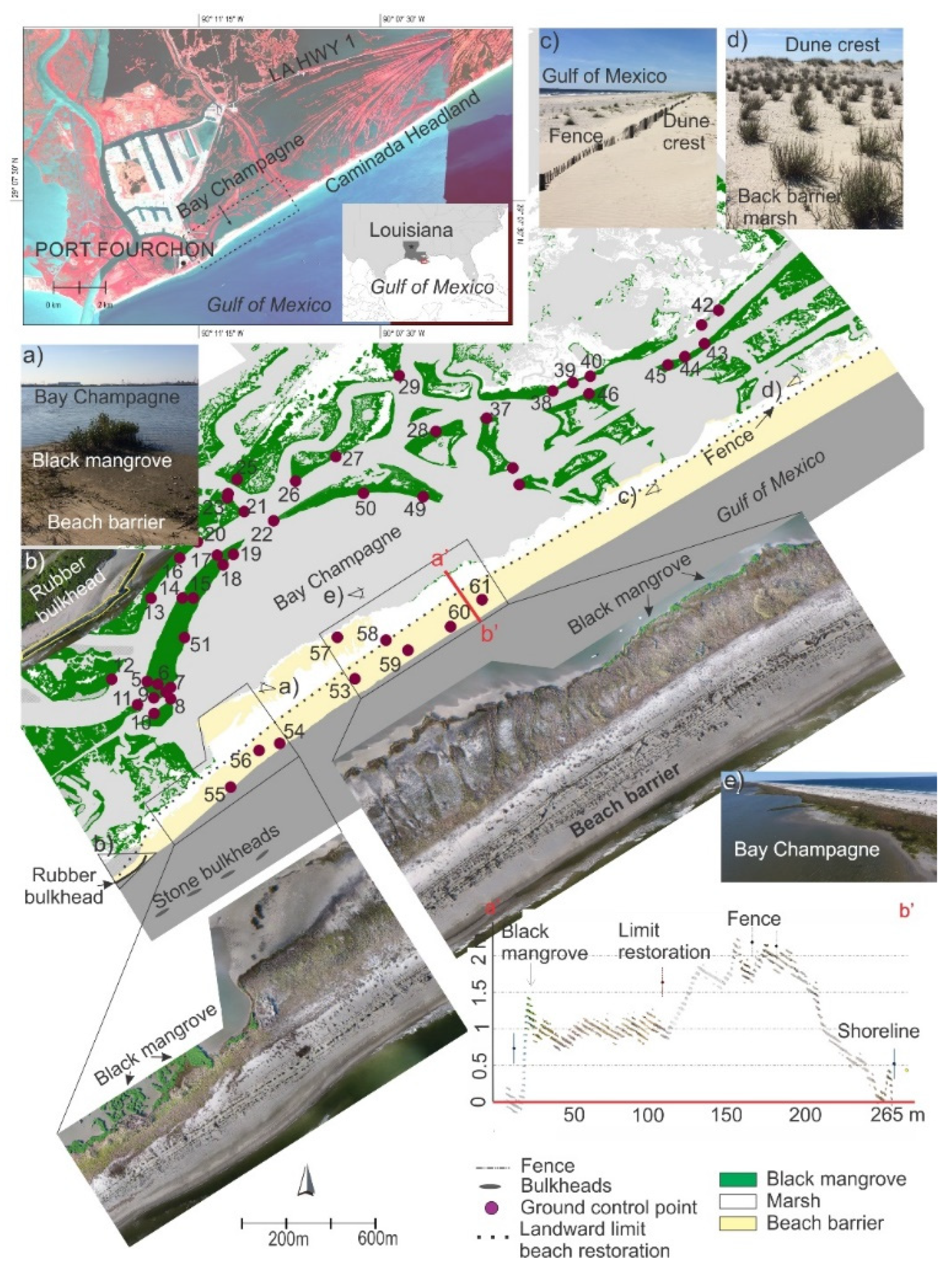
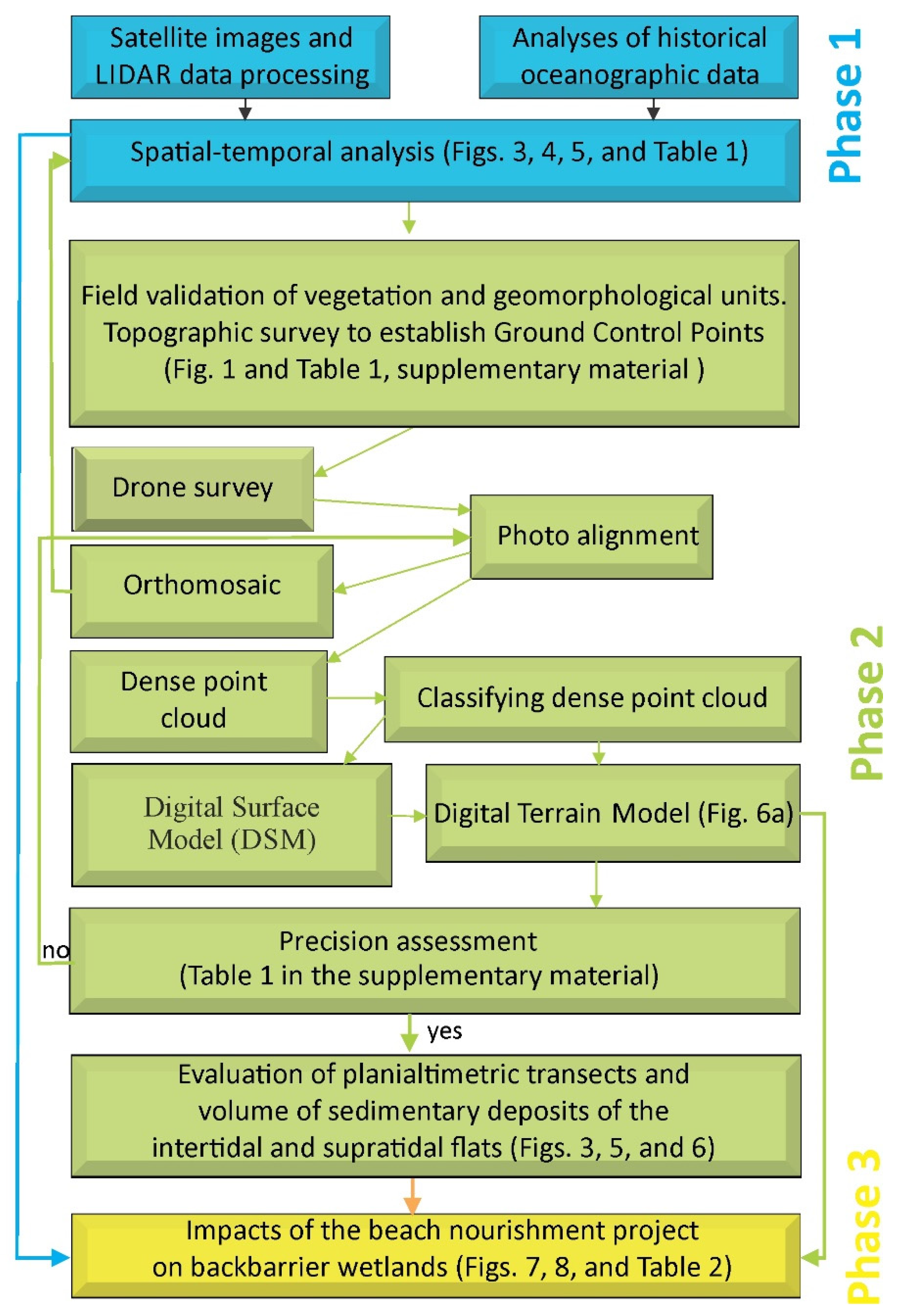
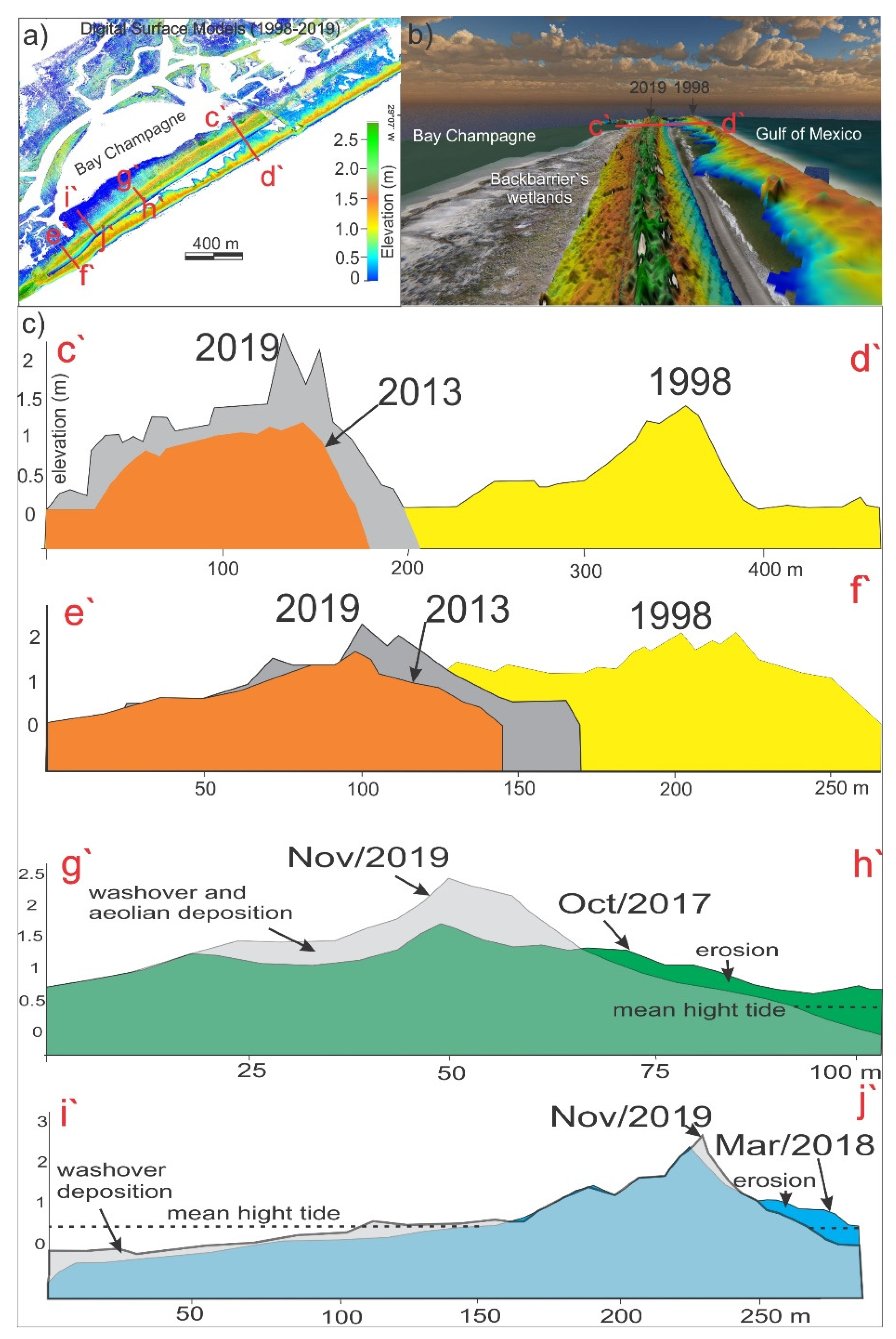
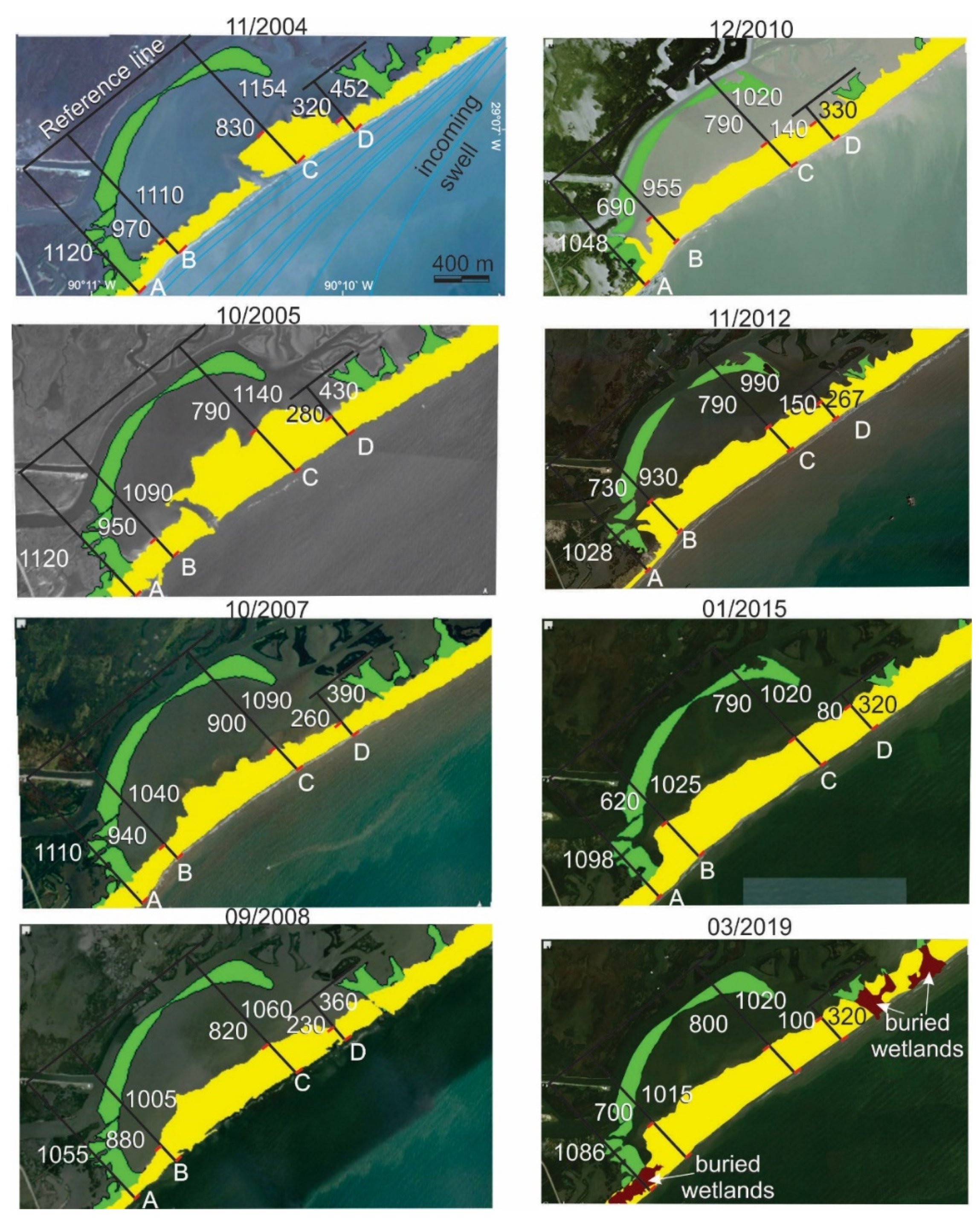


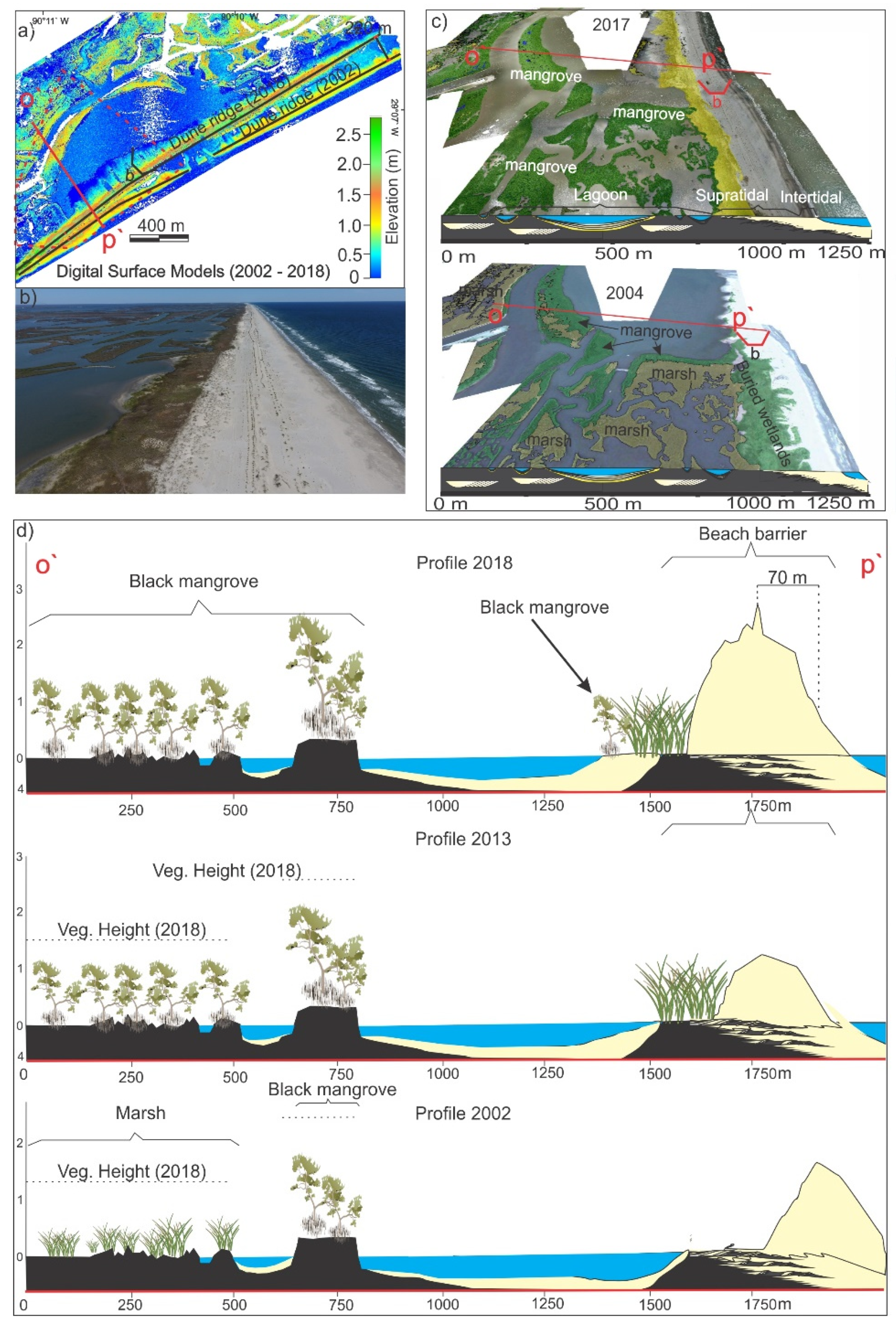
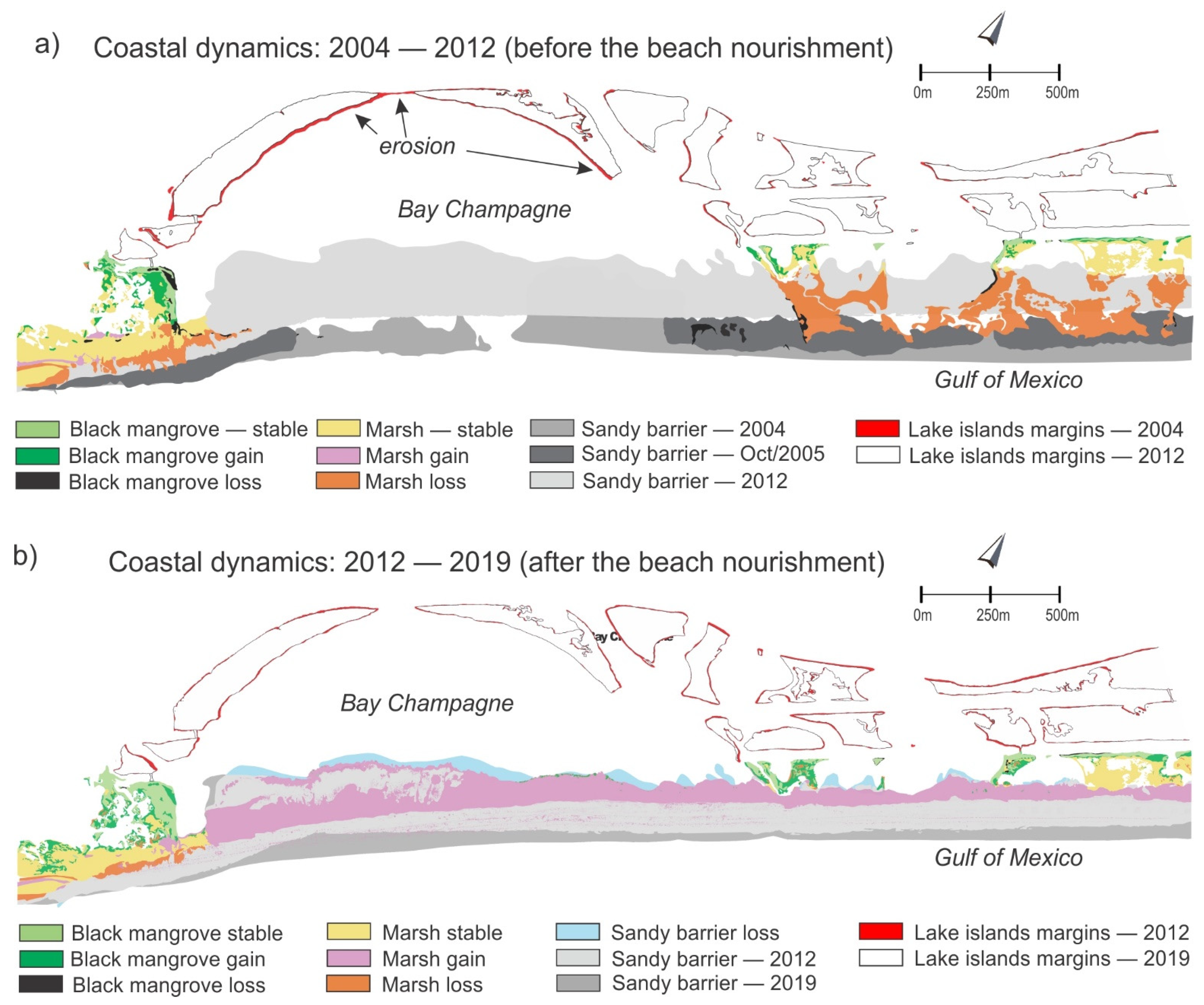
| Profile | Before Nourishment | After Nourishment | |||||||
|---|---|---|---|---|---|---|---|---|---|
| 2004-05 11 Months | 2005-07 24 Months | 2007-08 11 Months | 2008-10 26 Months | 2010-12 23 Months | 2004-12 95 Months | 2012-15 26 Months | 2015-19 50 Months | 2012-19 76 Months | |
| A–Mangrove | 0 | −10 | −55 | −7 | −20 | −92 | 70 | −12 | 58 |
| B–distal | −20 | −50 | −35 | −50 | −25 | −180 | 95 | −10 | 85 |
| C–distal | −14 | −50 | −30 | −40 | −30 | −164 | 30 | 0 | 30 |
| D–distal | −22 | −40 | −30 | −30 | −63 | −185 | 53 | 0 | 53 |
| Mean | −14 | −37.7 | −37.5 | −31.7 | −34.5 | −155 | 62 | −5.5 | 56.5 |
| B–proximal | −20 | −10 | −60 | −190 | 40 | −240 | −110 | 80 | −30 |
| C–proximal | −40 | 110 | −80 | −30 | 0 | −40 | 0 | 10 | 10 |
| D–proximal | −40 | −20 | −30 | −90 | 10 | −170 | −70 | 20 | −50 |
| Mean | −33.3 | 26.6 | −56.6 | −103.3 | 16.6 | −150 | −60 | 36.6 | −23 |
| Oceanograp. data | |||||||||
| RSL (mm) | 8.3 | 18.16 | 8.3 | 19.67 | 17.4 | 71,83 | 19.67 | 37.83 | 57.5 |
| Fluvial discharge (ft3/s) | 303 –201 | 247 –100 | 196 – 103 | 235–145 | 211–125 | 303–100 | 320–61 | 511–296 | 511–61 |
| Before Nourishment | After Nourishment | |||
|---|---|---|---|---|
| Veget./Geomorphological Unit | Gain (ha) | Loss (ha) | Gain (ha) | Loss (ha) |
| Mangrove | 2.2 | 1.1 | 3.2 | 0.07 |
| Marsh | 0.5 | 14.5 | 26.9 | 1.4 |
| Sandy intertidal flat | 0 | 31.5 | 14.3 | 4.1 |
Publisher’s Note: MDPI stays neutral with regard to jurisdictional claims in published maps and institutional affiliations. |
© 2021 by the authors. Licensee MDPI, Basel, Switzerland. This article is an open access article distributed under the terms and conditions of the Creative Commons Attribution (CC BY) license (https://creativecommons.org/licenses/by/4.0/).
Share and Cite
Cohen, M.C.L.; de Souza, A.V.; Liu, K.-B.; Rodrigues, E.; Yao, Q.; Pessenda, L.C.R.; Rossetti, D.; Ryu, J.; Dietz, M. Effects of Beach Nourishment Project on Coastal Geomorphology and Mangrove Dynamics in Southern Louisiana, USA. Remote Sens. 2021, 13, 2688. https://doi.org/10.3390/rs13142688
Cohen MCL, de Souza AV, Liu K-B, Rodrigues E, Yao Q, Pessenda LCR, Rossetti D, Ryu J, Dietz M. Effects of Beach Nourishment Project on Coastal Geomorphology and Mangrove Dynamics in Southern Louisiana, USA. Remote Sensing. 2021; 13(14):2688. https://doi.org/10.3390/rs13142688
Chicago/Turabian StyleCohen, Marcelo Cancela Lisboa, Adriana Vivan de Souza, Kam-Biu Liu, Erika Rodrigues, Qiang Yao, Luiz Carlos Ruiz Pessenda, Dilce Rossetti, Junghyung Ryu, and Marianne Dietz. 2021. "Effects of Beach Nourishment Project on Coastal Geomorphology and Mangrove Dynamics in Southern Louisiana, USA" Remote Sensing 13, no. 14: 2688. https://doi.org/10.3390/rs13142688
APA StyleCohen, M. C. L., de Souza, A. V., Liu, K.-B., Rodrigues, E., Yao, Q., Pessenda, L. C. R., Rossetti, D., Ryu, J., & Dietz, M. (2021). Effects of Beach Nourishment Project on Coastal Geomorphology and Mangrove Dynamics in Southern Louisiana, USA. Remote Sensing, 13(14), 2688. https://doi.org/10.3390/rs13142688







